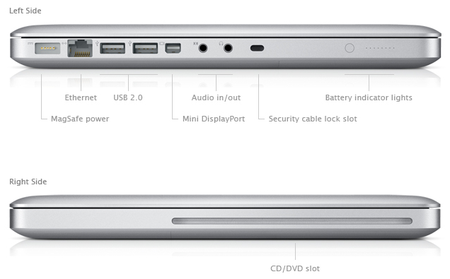This article is more than 1 year old
Apple MacBook
A complete overhaul only improves this neat notebook
And that’s pretty much what they got - the new MacBook is, in essence, a slightly smaller version of the MacBook Pro. Think of it as the 13in MacBook Pro that sits alongside the new 15.4in MacBook Pro and the upcoming revamped 17in model. The cheap-and-cheerful white and black plastic shells of the original MacBook have been replaced with a far more tasteful – but expensive – matte-finish aluminium chassis that's virtually identical to that of the new MacBook Pro models also released this is month - although its curved edges also owe something to the design of the ultra-portable MacBook Air.
Unlike the Air, you can easily remove the battery from the MacBook - there's a flip-up catch on the base. Under the hatch, you'll find the battery and the hard drive, which is likewise straightforward to swap for a higher-capcity model or an SSD, should you fancy one. The memory's harder to upgrade - it's under the baseplate, which is held down by half-a-dozen or so screws.
From an aesthetic point of view, the aluminium design is certainly more attractive, and it also allows Apple to streamline the MacBook a bit too. Both size and weight have been trimmed by about ten per cent, with this new model measuring just 2.4cm thick when shut, and weighing a fraction over 2kg. The entire keyboard area is made out of a single piece of aluminium - again, just like the Air - which Apple refers to as a "unibody".

New design, new port array
This helps to keep the weight down, while the rigidity of the single sheet of metal also ensures that the unit is more robust than the light plastic of the previous model. As is so often the case with Apple products, the sheer quality of the design - and you really have to get in your hands to appreciate it - goes a long way to overcoming doubts about the price.
Even so, if the new MacBook is more expensive than its predecessor then it needs to provide more than just good looks. The basic processor speeds haven’t improved much, although increasing the frontside bus speed for both processor and memory to 1GHz does boost performance somewhat. So does the the use of DDR 3, in improvement on the old models' slower DDR 2.
But the real kick in the pants comes from the use of Nvidia’s GeForce 9400M chipset.
The most recent MacBooks used Intel’s integrated GMA X3100 graphics core, part of the chip giant's 965GM chipset. It wasn't bad for general work and decoding DVDs and digital video, but it wasn’t up to the task of playing the latest generation of 3D games. This meant that the MacBook was, frankly, absolutely rubbish as a games machine. We can still remember the time we tried to run Quake Wars on our old white MacBook and managed to get something in the region of one frame per fortnight.
Apple claims that the graphics core integrated into the 9400M is five times faster than the one built into earlier MacBooks – although to some extent the numbers here are almost irrelevant as our white MacBook simply falls flat on its face when we try to load recent games such as Call of Duty 4. So the mere fact that the new MacBook can run games such as this at all is an improvement.
